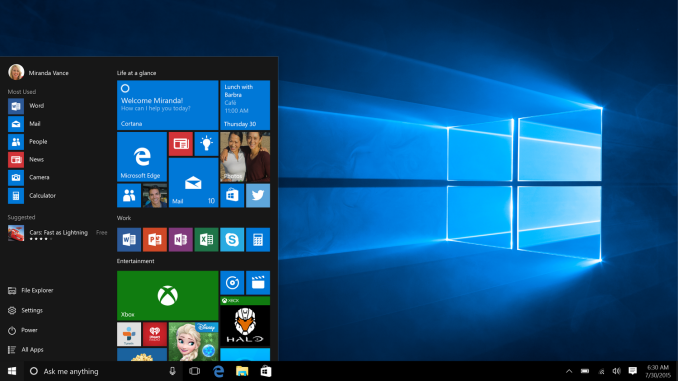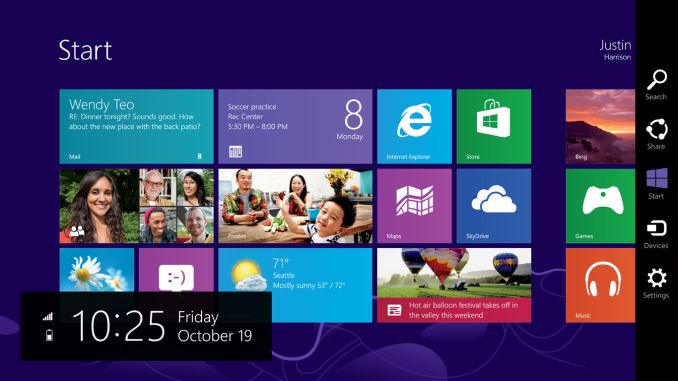The Windows 10 Review: The Old & New Face of Windows
by Brett Howse on August 25, 2015 8:00 AM EST- Posted in
- Operating Systems
- Microsoft
- Windows 10

Let’s flash back to 2012. About three years ago, Windows 8, the last major release of Microsoft’s ubiquitous operating system, was released to manufacturers. This was to be Microsoft’s most ambitious release yet. Traditional PC sales were in decline, and more personal devices such as the iPad tablet were poised to end the dominant PC platform. Microsoft’s response to this was to change Windows more than in any previous release, in a bid to make it usable with the tablet form factor. Windows 8 launched in October 2012 to much fanfare.
There was much fanfare, but little in the way of sales. Yes, Microsoft did sell many copies of Windows 8, but it did not help the declining PC market rebound. Windows 8 came to be with a touch first interface, with a new Start Screen replacing the traditional Start Menu, and a new breed of Windows 8 apps, which run on the WinRT framework. These WinRT apps have been named many things over the past three years, starting with Metro apps. A trademark dispute ended that naming scheme though, and over time they have morphed from full screen apps to universal apps to Windows Store apps, and practically none of them were able to rival the older Win32 platform in popularity or productivity.
Windows 8 did bring some great features to Windows, but they were overshadowed by the major design shift which, while good as a touch based operating system, alienated many who still used Windows on a traditional desktop or notebook. The Start Screen was a big turn off to many people, and full screen apps were not very efficient on a large screen display. Even the multitasking in Windows 8 was less than ideal, with the initial release only allowing two Windows Store apps to be open at any one time, and the second was relegated to a small side bar.
Microsoft’s own faith in Windows 8 was clearly not strong. Only a couple of weeks after Windows 8 launched, they unceremoniously dumped the project head Steven Sinofsky from the company, and spent the next two years trying to make Windows 8 more usable on traditional mouse and keyboard type machines, which were the vast majority of Windows devices in the hands of users. Windows 8.1 arrived and fixed some of the key issues with Windows 8, and 8.1 Update launched with the ability to boot to the desktop, and avoid the touch interface almost completely if you wanted to.
 Windows 10 Start Menu and Desktop view
Windows 10 Start Menu and Desktop view
When looking at Windows 10, I think it is pretty important to look back over the last three years, because none of this is ever built or designed in a vacuum. Microsoft has a huge number of devices running Windows, but a large majority of them are running Windows 7, which was an evolutionary desktop upgrade. Windows 8 struggled to ever take over any of that usage share. Windows 10 is Microsoft’s attempt to bridge the divide. Windows 7 is used by hundreds of millions of people, but its touch support is practically zero. Windows 8 works well in a touch scenario, but is not ideal for keyboard and mouse based devices. Windows 10 promises to be the version of Windows which bridges this gap.
Windows 10 brings about as much change as Windows 8 did, but in almost all cases it is going to be appreciated by users rather than avoided. It will run on a dizzying number of device types, including the traditional desktop, notebook, tablet, two-in-one, phone, IoT, Raspberry Pi, Hololens, Surface Hub, and even Xbox One. What it will bring to each of those device types is not the single interface that Windows 8 pushed on the desktop, but a unified app platform. Each device type will have its own interface, but the underlying app platform will allow developers to target a huge number of devices. And developer buy-in is the one thing Microsoft needs more than any other in order to make this vision succeed. For all of Windows 8’s quirks, it was really the lack of quality apps in the Windows Store which was the one hurdle Microsoft could not code around. Only time will tell whether or not the new model succeeds where the old one failed, but at the beginning of the life of Windows 10 we can go through all aspects of it and see what’s new, what’s changed, and how it fits in on today’s devices.











293 Comments
View All Comments
Brett Howse - Wednesday, August 26, 2015 - link
Thanks for the catch on that one :)abhaxus - Wednesday, August 26, 2015 - link
Had a full screen takeover/scrolling ad when trying to read this article. Similar to the Tom's Hardware ads. I don't read that website anymore, and I will stop reading this one if it continues to happen.Anne Druide - Thursday, August 27, 2015 - link
Only 30 minutes in and it is obvious to me that Microsoft has dropped the ball it had picked up with Windows 8.1. (1) Microsoft's efforts at fixing Windows continue to be APITA (a pain you know where)! WHY did they have to completely obliterate the Charms? Why not just have left them along the right side of the new Action Center? I mean really? Did that NOT cross any of the brilliant minds at MS? WHY remove such a distinctive and unique feature of 8.1. Why not integrate it into 10? (2) Furthermore, just as 8.1 had swung maybe (maybe not) too far towards the tiles, 10 has swung WAY too far towards the desktop. Now, to get to the Metro Tiles Menu it takes TWO steps! Why in the world does pressing the offscreen Window button bring up the Start Menu INSTEAD of the Metro Menu? The Start Menu ALREADY has its own Window icon! And what's a TOTAL WASTE is that pressing on the offscreen Windows button while in Tablet mode and on the Metro Menu does ABSOLUTELY NOTHING! It does not even bring up the Start Menu which would have been a great idea! Duh! (3) Finally, I feel that MS has lied about BRINGING BACK THE START BUTTON! Clicking on the Windows button located where the Start button was in Windows 7 does NOT bring anything up even remotely close to what we had in Windows 7! When I press the Start button I DON'T wanna see tiles; I wanna see all the practical functionality of what came up in Windows 7 when I pressed Start! INSTEAD, I get a very confusing flotsam and jetsam mish-mash of everything under the sun instead of quick access to the Control Panel and Task Bar content and...OMG there's no longer any user control of Windows Update?!!! All in all, my first 30 minutes with Windows 10 has been, as you can tell, VERY disappointing! WHY is it SO HARD for MS to JUST GET IT RIGHT! This is NOT even close to what Windows 10 SHOULD be. This is a limping Windows 9 with the 10 thrown in JUST not to look light years behind Apple's OS X whose TEN has been a thorn in the side of MS for how many years now?!mapesdhs - Thursday, August 27, 2015 - link
Still looks to me like MS wants people to have a phone interface on a desktop, which is stupid. So many things once again look incredibly unprofessional, and the lack of configurability is just ridiculous. It makes the coding of this latest release look so amateurish. The smiley in the very first review image is typical. I could make a list of everything else which is stupid (eg. no Save As from right-button), but who has the time, and I'm sure the 22 pages of comments have covered them all already.I don't want to use an OS that looks like a phone interface. I'll keep using Win7 until MS offers something sensible.
straighttalk - Thursday, August 27, 2015 - link
Totally useless review. No content, just a lot of opinion. Where's the beef? What are the issues? What problems are people who upgrade having?SteelRing - Thursday, August 27, 2015 - link
WiFi Sense is the antithesis of privacy and security, you should allow it if you are naive or an MS worshipper or both. Should you upgrade from Win8(.1)? For sure... Should you upgrade from Win7? I'd say if it aint broke dont fix it. I'm personally glad that Win10 finally allows me to buy laptop again, laptop that works and not just a toy. I want a keyboard and a mouse with my computer and Win10 finally lets me have it again. People who want to smear their screens with their fingers seem to be happy with Win10 too, none of my business though. If Win10 had not come out I'd be scavanging refurb laptops with Win7, thank goodness I don't have to.Oxford Guy - Thursday, August 27, 2015 - link
Microsoft is apparently doing its best to make sure it is broken. Here is a list I found of patches to avoid, due to things like added in "telemetry" (spying) or bug introduction:KB3075249, KB3080149, KB2505438, KB2670838, KB2952664, KB2976978 (8 only), KB3021917, KB3035583, KB3075249
Notmyusualid - Saturday, August 29, 2015 - link
Thanks, but cleared out a couple of those already.Zak - Thursday, August 27, 2015 - link
"for most people, they will make the trade-off of less privacy if it means an improved experience. The textbook example here is advertising, where in order to deliver relevant ads to the user (or rather not serve them useless ads) the ad service must be able to learn something about the user and their preferences" -- Are you out of your mind??? Trade my privacy for relevant ads? You ought to be on drugs or MS is paying you to post this drivel. Nobody likes to be blasted with ads, relevant or not. If they system really wants to learn something it is this: NOBODY LIKES ADS.jameskatt - Friday, August 28, 2015 - link
The absolutely WORSE thing about Windows 10 is now much it is tracking you - tracking the websites you read, the apps you use, tracking how much time you spend on a web page, etc. And you cannot turn this tracking off. It is totally creepy that Windows includes so much spying.Some parents may love this in that they get a monthly report from Microsoft of every webpage and app their children use.
But for the vast majority of users and parents, this is simply unacceptable.
Someone has to give us a privacy utility to block Microsoft from tracking us so heavily.